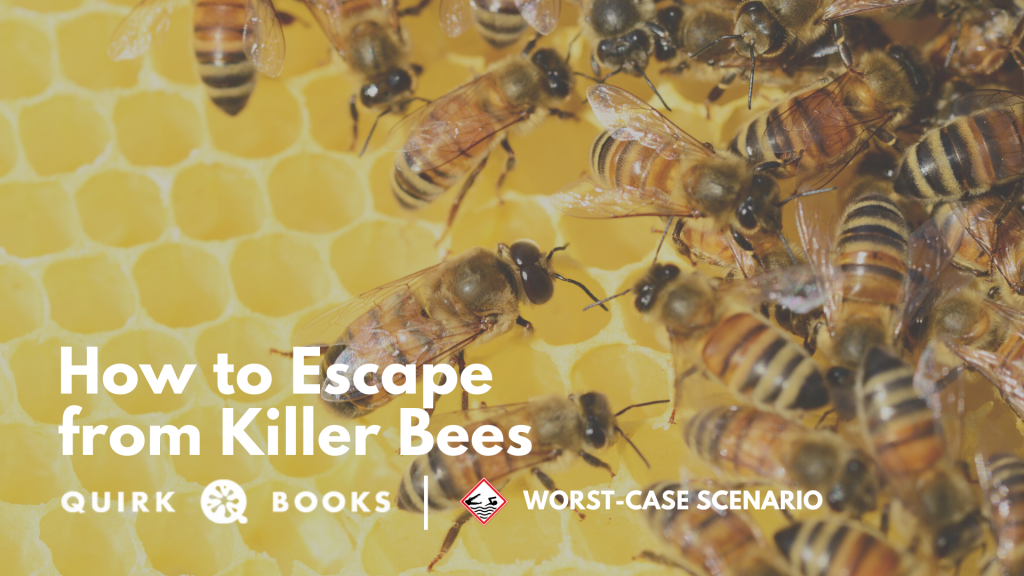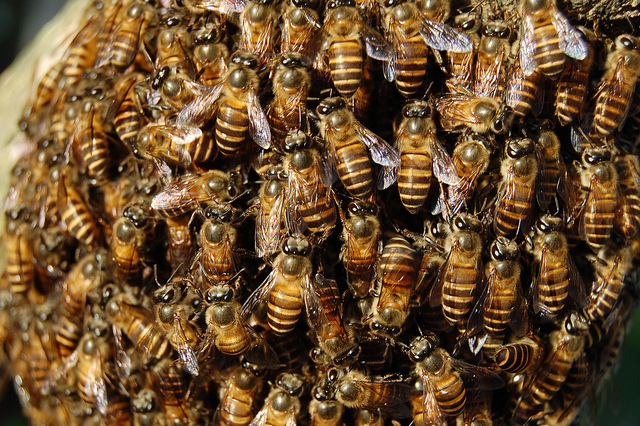Summer Survival Week: How to Escape from Killer Bees
(Header image created via Canva)
While “Tracker Jackers” may not actually exist, here’s how to handle killer bees of any sort.

HOW TO ESCAPE FROM KILLER BEES
- Run:
If bees begin flying around and/or stinging you, do not freeze. Run away.
- Shield vulnerable areas:
Cover eyes and nose with your shirt to protect these sensitive areas, but make sure you can still see where you are running. If small children are present, pick them up and take them with you.
- Do not swat:
Bees are attracted to movement, and killed/crushed bees emit a scent that will attract more bees. Swatting at the bees only makes them more aggressive.
- Get indoors as fast as you can:
The bees will follow you indoors, but will become confused by bright lights and windows, and tracking you will become more difficult. Once inside, get under thick blankets and sheets until the bees dissipate.
- If no shelter is available, run through bushes or high weeds:
This will help give you cover and make bee navigation more difficult.
- If a bee stings you, it will leave its stinger in your skin:
Remove the stinger by raking your fingernail across it in a sideways motion. Do not pinch or pull the stinger out—this may squeeze more venom from the stinger into your body. Do not let stingers remain in the skin, because venom can continue to pump into the body for up to 10 minutes. Drag a dull knife or credit card across the skin to help remove stingers.
- Do not jump into a swimming pool or other body of water:
The bees are likely to be waiting for you when you surface.

RISK OF ATTACK
-
The Africanized honeybee is a cousin of the run-of-the-mill domesticated honeybee. The “killer bee” moniker was created after news reports about several deaths that resulted from Africanized bee stings. Africanized honeybees are considered “wild”; they are easily angered by animals and people, and likely to become aggressive.
-
Bees “swarm” most often in the spring and fall. This is when the entire colony moves to establish a new hive. They may move in large masses until they find a suitable spot. Once the colony is built and the bees begin raising their young, they will protect their hive by stinging.
-
While any colony of bees will defend its hive, Africanized bees do so with gusto. These bees can kill, and they present a danger even to those who are not allergic to bee stings. In several isolated instances, people and animals have been stung to death. Regular honeybees will chase you about fifty yards. Africanized honeybees may pursue three times that distance.
-
Most often, death from stings occurs when people are not able to get away from the bees quickly. Animal losses have occurred for the same reasons—pets and livestock were tied up or penned when they encountered the bees and could not escape.
HOW TO AVOID AN ATTACK
-
Avoid colonies by filling in holes or cracks in exterior walls, filling in tree cavities, and putting screens on the tops of rainspouts and over water meter boxes in the ground.
-
Do not bother bee colonies: if you see that bees are building—or have already built—a colony around your home, do not disturb them unless they are causing a specific hazard or problem. Call a pest control center to find out who removes bees. If the hive seems to host honeybees, contact a local beekeeper, who may be able to help relocate them.
PRO TIP
- A nonallergic person can survive about 10 bee stings per poud of body weight, albeit uncomfortably.
For more Worst-Case Scenario content, go to WorstCaseScenario.com!
(Excerpt from The Worst-Case Scenario Survival Handbook.)




